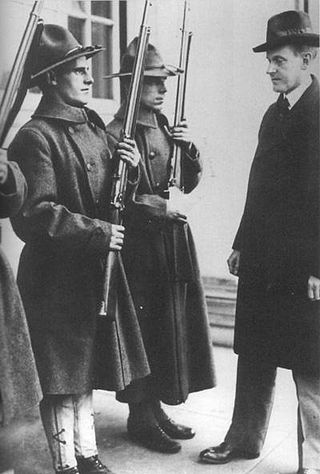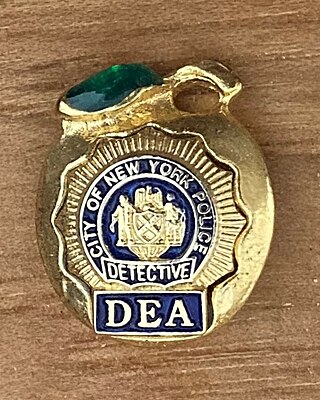Structure
Police are still highly unionized in the United States in the 21st century, in contrast to the declining union membership of other professions in both the public and private sectors. High union membership rates among police and other law enforcement officers significantly raise the average. [11]
- The police labor movement is divided into two camps -- the independent police labor organizations and the police labor organizations affiliated with organized labor through the AFL-CIO or CtW. Approximately 80-85 percent of all police labor organizations would be classified as independent and have no affiliation with organized labor. There are no accurate reports on how many of the 800,000 sworn officers are members of a police union. The best estimate would be 75-80 percent; that would rank police officers with firefighters as having the highest unionization rates in the United States. [1]
The New York City Police Department is the largest in the country. With roughly 35,000 sworn officers, it's three times larger than the next-biggest, Chicago. It supports five separate unions, according to various ranks (patrol officers, sergeants, lieutenants, detectives, and captains): [12] [13]
- Police Benevolent Association of the City of New York, [14] which describes itself as the "largest municipal police union in the world" representing 24,000 members "who hold the rank of Police Officer". [2] Between 1999 and 2023, its leader was Patrick Lynch. [15]
- Detectives' Endowment Association, which claims representation of 5,500 active and 12,000 retired New York City Police Detectives. [16]
- Sergeants Benevolent Association
- Lieutenants Benevolent Association
- Captains' Endowment Association, representing the ranks of Captain, Deputy Inspector, Inspector, Deputy Chief, and Surgeon [17]
The other four cities in the U.S. with over 5,000 police officers [18] correspond with the four next-largest independent municipal labor unions by total membership:
- Chicago Lodge #7 of the Fraternal Order of Police
- Los Angeles Police Protective League
- Philadelphia Lodge #5 of the FOP
- Houston Police Officers' Union
Police associations and organized labor
Of the 20 to 25% of police unions with affiliations with organized labor, the largest is the International Union of Police Associations, which chartered with the AFL–CIO in 1979. It has over 15,000 members. [1] [19]
Other union affiliates include the International Brotherhood of Police Officers, which is part of National Association of Government Employees (SEIU/CtW).
Amid calls to remove police from the labor movement in 2020, member affiliates of the west coast King County Labor Council brought two motions to reform and / or expel the Seattle Police Officer Guild, [20] the largest police union in the northwest. On June 8, 2020 the Writers Guild of America, East called on the AFL-CIO to dismiss the IUPA. [21] [22]
Sometimes described as a "union," the National Association of Police Organizations is solely a lobbying organization. [23]
Police Benevolent Associations

A Police Benevolent Association, or Policemen's Benevolent Association, or Patrolmen's Benevolent Association (PBA), is a frequently used name for law enforcement labor unions in the U.S. Examples include the New Jersey State Policemen's Benevolent Association, the Police Benevolent Association of the City of New York, the Ohio Patrolmen's Benevolent Association, the Boston Police Patrolmen's Association, and the Cleveland Police Patrolmen's Association.
Courtesy cards
Several Police Benevolent Associations have a tradition of distributing courtesy cards to friends and family members of police officers. In 2012, the director of the Police Institute at Rutgers University stated that the practice was at least 40 years old and probably much older. [24] While police departments have repeatedly denied that they support favoritism for cardholders, the cards have come to be called "get out of jail free cards" colloquially based on anecdotal reports that they have helped drivers receive a warning instead of a speeding ticket. [25] Officers speaking anonymously have supported the view that the cards are designed to help certain people avoid minor citations. [24]
The legitimacy of the cards is a subject of debate with critics maintaining that it is a form of police corruption for officers to take them into consideration. [26] A professor of police studies at John Jay College of Criminal Justice has said of the system that "it sets up different sets of rules". [27] In 2018, the number of PBA cards allotted per officer in New York was lowered from 30 to 20. This was in response to many of them appearing for sale online. [28] The New York Times prohibits its journalists from accepting the cards out of concerns that doing so would prevent them from covering the police objectively. [29]
In May 2023, NYPD officer Mathew Bianchi filed a lawsuit against his police captain and the City of New York, claiming the police department retaliated against him for his opposition to the PBA's courtesy cards. It alleged the NYPD violated Bianchi's first amendment right to speak out against "widespread corruption, illegal practices and the manipulation of issuance" of traffic tickets through the cards. [30] Specifically, Bianchi claimed that his decision to ticket some cardholders led to the PBA threatening to drop his union protection, and that he was ultimately reassigned from his traffic unit on Staten Island to a night patrol shift after he ticketed a friend of NYPD Chief Jeffrey Maddrey; Bianchi described that stop as "unremarkable" and said the friend did not mention she knew Maddrey. [31] [32]
Lobbying and activism
In addition to collective bargaining on behalf of their members, police unions engage in political advocacy around "law and order," crime legislation and legal protections for individual officers. [33] Efforts by the Department of Justice to regulate policing through consent decree, civilian oversight, and prosecution of police misconduct have been stalled or forbidden by police union contracts. [34] In 2014, the Fraternal Order of Police lobbied unsuccessfully for the continuation of Pentagon's 1033 program, which allowed for excess military equipment to be given to civilian police departments, after it was discontinued by President Obama. [35]
Police unions also generate significant political donations. Between 1994 and 2020, over 55 police unions donated $1 million to different federal election campaigns. [36] In the same time period, over $87 million was spent by police unions on lobbying and elections on the local level. [37]













